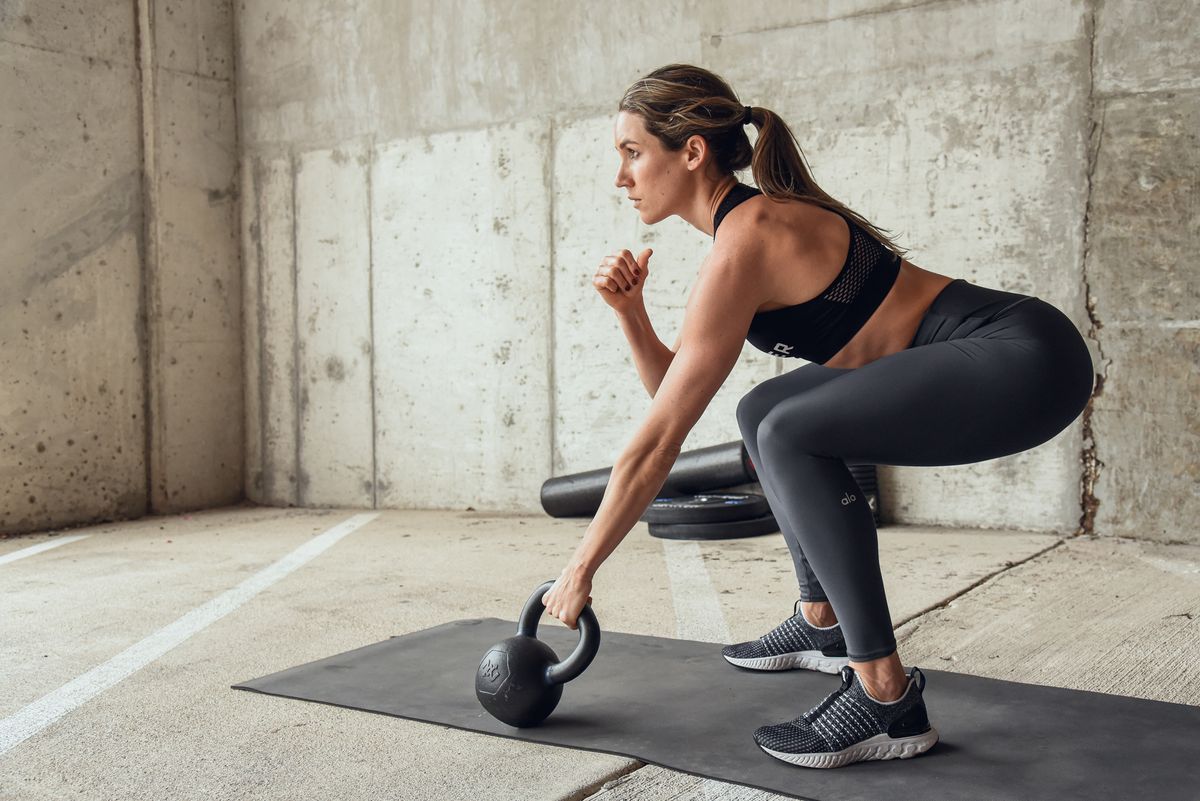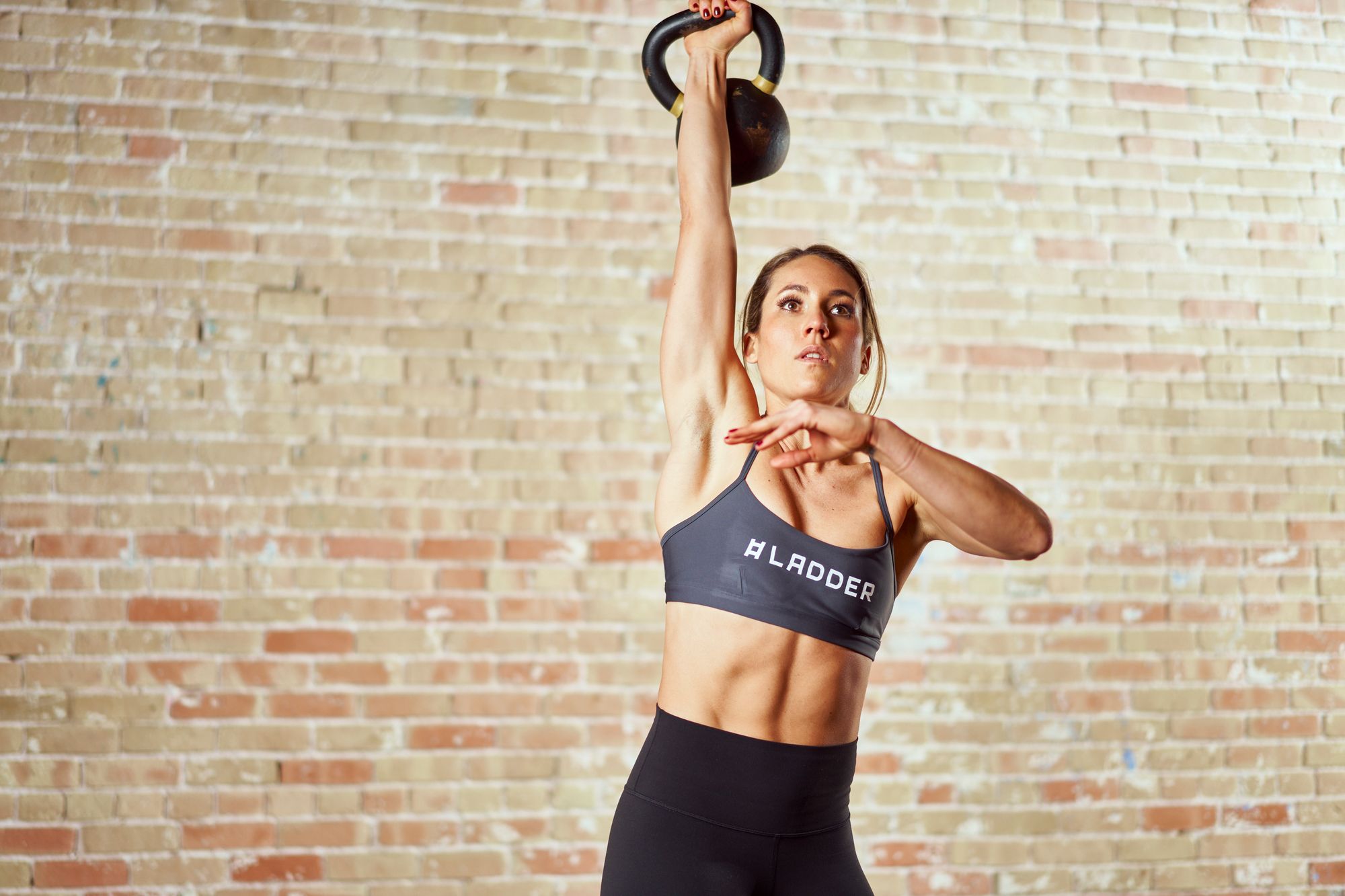How to Do a Kettlebell Snatch? (with video demonstration)

Learn the Kettlebell Snatch and How to Add it to Your Workout Routine

Lauren Kanski
Ladder Senior Coach, CPT

Kettlebell Snatch Introduction
The kettlebell snatch is one of the most dynamic movements in kettlebell training.
In this article and in my video demonstration, I’ll teach you how to master proper form of the kettlebell snatch and why you should add the snatch to your kettlebell workouts today.
I’ll also share some of the benefits of the snatch and help you avoid injury by showing you some of the common snatch and kettlebell mistakes that people make when learning the exercise.
Kettlebell Snatch Demonstration (audio & video)
Step-by-Step Instructions for the Kettlebell Snatch
Step 1:
Start in a “hike” position set up. Create a tripod between your feet and the kettlebell, making sure the kettlebell is out in front of your body so that you have to reach for it.
Drop your butt down, tuck your pelvis (draw your belly button towards spine), gaze four feet in front of you, and puff your chest forward.
Reach for the kettlebell and grab the horns with one arm. Tilt the bell back and drag it towards you slightly to lock your lat back and create tension with the kettlebell. No noodle arms here…make sure to lock out your wrist and elbow.
Step 2:
On an inhale, hike the kettlebell back behind your pelvis, like you're hiking a football, while keeping your butt down.
On an exhale, drive your hips forward to accelerate the kettlebell forward like you’re doing a kettlebell swing, except instead of swinging it out in front of you, bend your elbow at your belly button so that the bell starts to travel vertically instead of horizontally.
Step 3:
As the kettlebell travels up, keep it as close to your body as possible (you should be able to snatch in front of a glass window), and bring your hips all the way through into extension (a standing plank position).
Step 4:
As the kettlebell travels up about shoulder height, be patient and extend the arm to PUNCH the bell forward at about 11 o’clock.
Lock your elbow and wrist out over-head, and pull your shoulder down into its socket, like you're pulling your arm into a jacket, and stand tall.
Step 5:
To initiate the descent back down, inhale and flip the kettlebell over your wrist while pulling your elbow down towards your ribs. When the bell gets to your belly button, imagine you are pulling it behind you.
Throw it back behind your pelvis to load your hips so you can go into another snatch, like a slingshot.
Step 6:
Relax during the descent of the kettlebell so you can rest your muscles for a split second to go into another rep. This is a core concept of ballistic training, the art of being able to contract your muscles and then completely relax and turn them off. The best athletes in the world have all developed this skill.
Kettlebell Snatch Mistakes That Lead to Injury
Kettlebell training is a great way to increase power, build strength, and torch fat. But it's easy to get injured if you aren't careful. With the snatch in particular, there are a few common mistakes to watch out for to avoid hurting yourself.
Mistake #1:
Not mastering basic hinge mechanics like the deadlift and double/single arm kettlebell swing prior to the snatch. Although the snatch ends overhead, it is a hip dominant movement. It’s crucial to master hinge patterning and build power there before attempting the snatch. If you don't know how to use your hips, you’ll end up “muscling it up” and using too much upper body which can lead to injury and forearm pain.
Mistake #2:
Not warming up correctly. I recommend taking some arm bars or Turkish get-ups to work into the shoulders and hips. Then priming single leg patterning in the hip complex (hamstrings, glutes, and core) and feet with some single leg Romanian deadlifts and then powering the mind and hips with some swings.
Mistake #3:
Not keeping the kettlebell close enough to your body. I call it “casting” the bell away from you and not “taming the arc” so it travels in one straight line. When you “cast” the kettlebell, it causes an imbalance of forces which can lead to injury if not corrected quickly enough. It will also cause the bell to “bang” on the back of your wrist which is awkward and uncomfortable. Keep it close, think “quick hips” and “elbows back”.
Mistake #4:
Gripping the kettlebell too tightly. You obviously want to hang onto it but if you're gripping too tight, you’ll tear up your hands and the bell won't maneuver naturally in your hands.
Mistake #5:
Using too much weight OR too little weight. You need to have load to “correct” your movement mechanics and activate your hips but the snatch is also a very advanced exercise and the shoulder is very vulnerable in the overhead position.
I recommended starting with something more medium sized. Focus on form and if you want to make it harder or more explosive, you can make it feel heavier by moving it faster. F=mass x acceleration!
Mistake #6:
Less is more. You don’t need high volume work with the snatch. Take 3-5 reps per side to start out. If you want conditioning in the hips, take higher rep swings and strict presses to train the snatch!
The Benefits of the Kettlebell Snatch
The kettlebell snatch is a great tool to train dynamic strength and gain muscle and power, but it's also great for endurance training, getting your heart rate up and burning fat.
When done correctly, this exercise will help you build explosive strength through your hips, glutes, and legs while also working anti-rotational core and shoulder stability. The motion of snatching the kettlebell overhead and then lowering it back down before repeating again mimics jumping and throwing mechanics such as shooting hoops in basketball, throwing a ball or javelin which makes this exercise great for athletes.
The unique shape of the kettlebell, with its offset center of gravity, allows us to create more force and velocity with less weight. When snatched overhead, the way the kettlebell sits on the back of the wrist promotes mobility and stability which is great for upper body strength and resilience. It’s a great way to train power with less stress on the joints compared to barbell lifting.
You’ll find that mastering this exercise will increase your muscle strength and performance in other hip dominant movements like barbell deadlifts and overhead presses as it is their explosive partner.
How to Incorporate the Kettlebell Snatch Into Your Workout Routine
Kettlebell snatches are the last skill you should be learning on your kettlebell journey. Add them in low volumes after you've mastered the swing, clean and some press variations.
If you want to incorporate the kettlebell snatch into your routine here are some tips to get started:
- Learn how to use your hips and HINGE with good form - start with a light weight until you feel comfortable doing the movement safely. Try them with two hands and one.
- Then you can start adding swing mechanics to your training which is the explosive deadlift partner. Double arm and single arm.
- Learn the clean and press mechanics. Then start connecting the dots.
- Warming up and learning the arm bar and Turkish get-up is key for snatch prep to prevent injury.
Whether you're looking to add some variety to your routine, or you're short on time, or you’re just looking to improve your overall fitness level, this is a great exercise to build into your workout routine.

Lauren Kanski
Ladder Senior Coach, CPT
Lauren is a Senior Coach at Ladder, a NASM-certified personal trainer, nutrition coach, Women’s Health Advisor, and published fitness writer based in New York City. Lauren’s online training program, BODY & BELL, available exclusively on the Ladder app, features daily full body workouts with a focus on kettlebell skills development and progressions.

